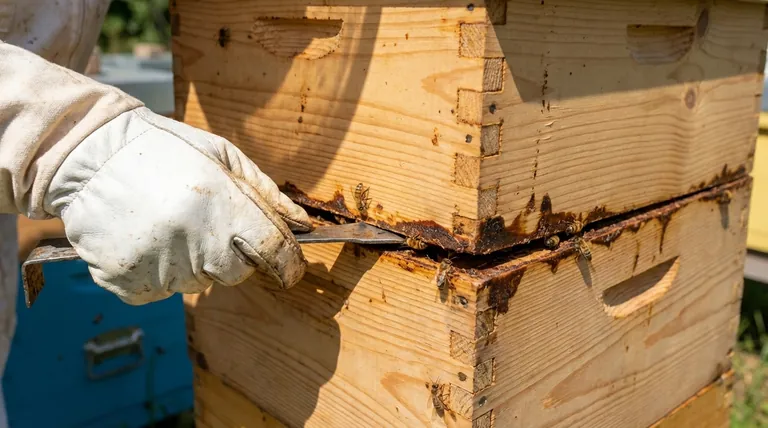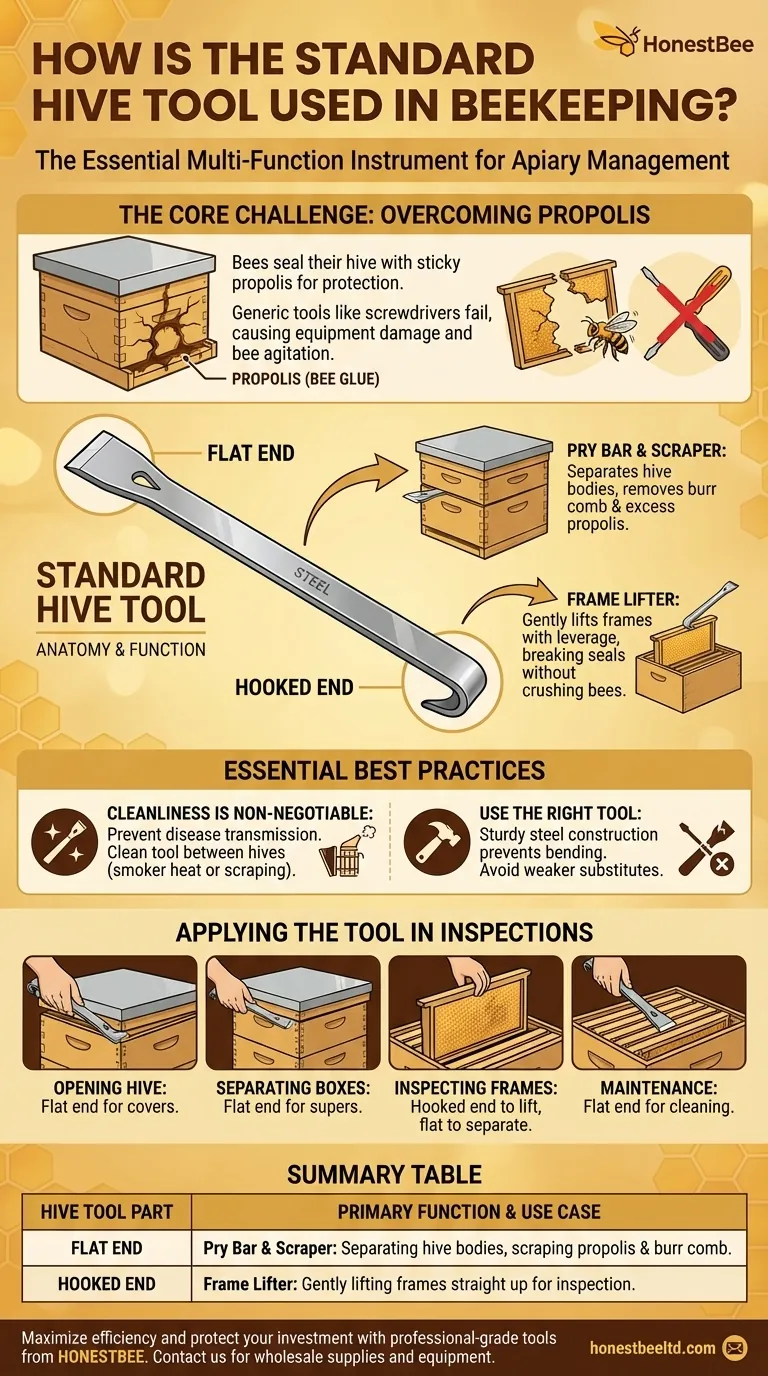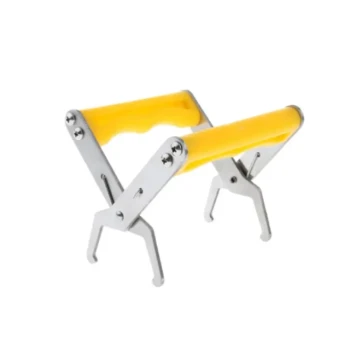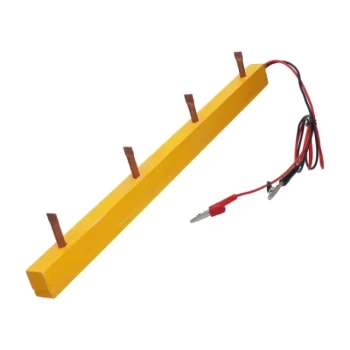A standard hive tool is a multi-function steel bar designed to be the beekeeper's most essential handheld instrument. It is used to pry apart hive components sealed by bees, lift out frames for inspection, and scrape away unwanted wax and propolis. Its two distinct ends—one flat and one hooked—are purpose-built to handle the most common tasks of hive management efficiently and safely.
The core challenge in beekeeping is that bees seal their entire hive with a sticky, resinous substance called propolis. A hive tool is not just a scraper or a lever; it is a specialized device designed to overcome this "bee glue" with precision, allowing you to manage the colony without damaging the equipment or harming the bees.

The Central Problem: Overcoming Propolis
Bees use propolis, a mixture of tree resin and beeswax, to seal every crack and seam inside their hive. They do this to protect the colony from weather, pests, and disease.
This "bee glue" is incredibly strong and effectively cements all hive components—lids, boxes, and frames—into a single, solid unit. Without a specialized tool, performing a hive inspection would be nearly impossible.
Why Generic Tools Fail
A common screwdriver or putty knife is a poor substitute for a hive tool. These tools lack the leverage, strength, and specific shapes needed for the job.
Using the wrong tool often results in splintered wood, damaged frames, and sudden movements that can agitate or crush bees, making hive inspections more difficult and stressful for both the beekeeper and the colony.
Anatomy of the Standard Hive Tool
The genius of the standard hive tool lies in its dual-ended design. Each end is engineered to solve a different set of problems you will encounter during an inspection.
The Flat End: The Pry Bar and Scraper
The wide, flat, chisel-like end is your primary tool for leverage and cleaning. Its sharp, beveled edge is perfect for inserting into tight seams.
You will use this end to separate hive bodies (supers) from one another and to pop the inner cover off the top of the hive. It is also the primary surface for scraping away excess propolis and burr comb from frames and hive walls, keeping your equipment clean and functional.
The Hooked End: The Frame Lifter
The J-shaped hook is designed for a more delicate task: lifting frames. The first frame in a box is often sealed tightly in place, and pulling it out can be difficult.
By resting the flat part of this end on an adjacent frame, you can use the hook to catch the ear of the frame you want to inspect. A gentle prying motion provides the leverage needed to lift the frame straight up, breaking the propolis seal without rolling or crushing the bees on the comb surface.
Essential Best Practices
Using a hive tool correctly involves more than just prying and scraping. Proper handling and maintenance are critical for the health of your bees and the longevity of your equipment.
Cleanliness is Non-Negotiable
As you move between hives, your tool can become coated in propolis, wax, and honey. These substances can easily transmit diseases and pests, like American Foulbrood spores or Varroa mites, from a sick colony to a healthy one.
Always clean your hive tool between inspecting different apiaries. For a quick clean between hives in the same yard, many beekeepers simply stab the tool into the ground a few times. For a more thorough sterilization, use the heat from your smoker's fire pot to burn off any residue.
Use the Right Tool for the Job
The hive tool provides the correct amount of force and leverage without damaging the wooden hive components. Its sturdy steel construction ensures it will not bend or break under the pressure required to separate heavily propolized boxes.
Resist the temptation to use a weaker tool. Investing in a proper hive tool prevents costly damage to your equipment and makes the entire process of beekeeping safer and more enjoyable.
Applying the Tool in Your Hive Inspections
Your hive tool is an extension of your hands. Knowing which end to use for each task will make your inspections smooth and efficient.
- If your primary focus is opening the hive: Use the flat, chiseled end to pry the outer and inner covers loose.
- If your primary focus is separating hive boxes: Insert the flat end into the seam between the boxes and gently pry them apart.
- If your primary focus is inspecting frames: Use the hooked end to gently lift the first frame, and the flat end to separate the remaining frames for easy removal.
- If your primary focus is hive maintenance: Use the sharpened edge of the flat end to scrape away unwanted burr comb and excess propolis from frames and box walls.
This simple, inexpensive bar of steel is the key that unlocks the beehive, empowering you to manage your colonies with confidence and care.
Summary Table:
| Hive Tool Part | Primary Function | Use Case |
|---|---|---|
| Flat End | Pry Bar & Scraper | Separating hive bodies, scraping propolis and burr comb. |
| Hooked End | Frame Lifter | Gently lifting frames straight up for inspection. |
Maximize your apiary's efficiency and protect your investment with professional-grade tools from HONESTBEE. We supply durable, purpose-built beekeeping supplies and equipment to commercial apiaries and distributors through our wholesale-focused operations. Ensure your operations run smoothly with the right tools for the job. Contact our team today to discuss your wholesale needs.
Visual Guide

Related Products
- Ergonomic High Visibility Plastic Frame Grip Handles
- Ergonomic Two Person Foldable Hive Lifter
- Professional Pneumatic Wire Embedder for Beehive Frames
- HONESTBEE Wooden Bar Copper Prong Wire Embedder for Battery Operation
- Manual Spur Wheel Wire Embedder for Foundation
People Also Ask
- What precautions should be taken when using a sharpened hive tool? Maximize Efficiency While Staying Safe
- What are the essential tools for a beekeeper? Build Your Confident Start in Beekeeping
- Should I buy a regular or J-hook hive tool? Choose the Right Tool for Your Beekeeping Needs
- What should you do after completing the hive inspection? Secure Your Hive and Document for Success
- Why are beekeeping tools important for hive management? Ensure Colony Health and Safety



















